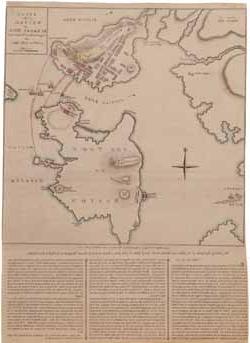A Plan of the Battle, on Bunkers Hill
To order an image, navigate to the full
display and click "request this image"
on the blue toolbar.
-
Choose an alternate description of this item written for these projects:
- Bunker Hill
- Main description
[ This description is from the project: Coming of the American Revolution ]
This map shows British fortifications on the Boston peninsula and the positions of both British and colonial troops on 17 June 1775. The map was published in London in the fall of 1775, and also ncludes a printed version of a letter from General John Burgoyne to his nephew Lord Stanley. Writing from Boston on 25 June 1775, Burgoyne described the Battle of Bunker Hill this way, "And now ensued one of the greatest scenes of war that can be conceived."
"Masters of these Heights"
By late April 1775, British troops garrisoned on the Boston peninsula are surrounded by 20,000 colonial militia in the outlying countryside. The siege of Boston has begun. The geography of Boston and Charlestown is laid out in both the map drawn by an "Officer on the Spot" and the letter from General Burgoyne to his nephew, Lord Stanley. General Burgoyne, who has only just arrived in Boston in late May, describes the vital importance of the high ground surrounding Boston in both Charlestown and Dorchester and why "it was absolutely necessary to become masters of these heights." Burgoyne, a veteran of the Seven Years' War in Europe, details the original plan to capture the heights, and explains what caused that plan to change. The map shows British fortifications on the Boston peninsula and the positions of both British and colonial troops on 17 June 1775.
Questions to Consider
1. Why were both the colonists and the British anxious to control the hilly areas of Charlestown and Dorchester?
2. What precipitated the change in the original British plans?
Further Exploration
3. The map marks the routes and landing sites of the boats with the British troops. There is also a notation "Hither the ships should have come" on one section of the map. Why did the officer/mapmaker add that? Using the map and Burgoyne's letter, argue for or against his position.

